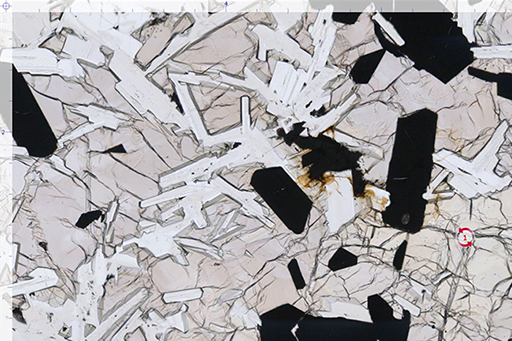1.3 Patchy evidence
Here you can see patches of what appear to be rust staining surrounding some of the black patches. There are three minerals in this field of view, the pinkish-grey mineral is pyroxene, the clear mineral is plagioclase, and the opaque areas are the metal oxides and sulfides (appearing black in plane-polarised light because no light passes through the thin section).
These apparently rusty patches surrounding some of the opaques are a mineral called akaganeite, formed from the hydration of some iron sulfides. It frequently occurs in samples exposed to humid conditions or small amounts of water. This discovery revitalised the argument over the hydration of the Moon.
However, the discovery was met with great scepticism as the dry moon theory was linked to the hypothesis that the Moon formed when a large planetesimal impacted into the Earth, driving off all volatile elements and leaving behind a dry moon. The apparent rust in this sample was at odds with this hypothesis and so other explanations were sought.
If you’ve enjoyed using the Virtual Microscope and want to know more, visit Open University minerals under the microscope [Tip: hold Ctrl and click a link to open it in a new tab. (Hide tip)] , with more info on identifying minerals and their characteristic features.

